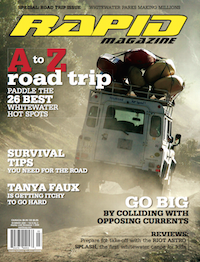Whitewater paddlers are shedding their reputation for being dirtbags and may soon be better known as moneybags, according to speakers at a recent symposium where promoters of manufactured whitewater dis- cussed the economic benefits of urban paddling parks.
With whitewater parks located in downtown cores, paddlers have no choice but to trade cooking on campstoves and sleeping in vans for fancy restaurant meals and cozy hotel rooms. At the symposium in Colorado, city councillors from Golden, Colorado, said paddlers visiting its whitewater park—which cost $170,000 to build—spent $3 million at local businesses last summer; and in Vail, Colorado, retailers estimated ringing up $1 million in sales during just one week of rafting and whitewater events in 2005.
The first whitewater park in the United States was built in Denver, Colorado, in 1978. Since then, they’ve sprung up in droves—from Reno, Nevada, to Charlotte, North Carolina—according to Scott Shipley, a three-time U.S. Olympic kayaker and now an engineer with a firm that builds the parks.
Shipley estimates that there are currently 40 to 60 parks in the United States, many in downtown cores, but in Canada the closest thing to a whitewater park remains the altered flows and rearranged features of natural waterways like Alberta’s Kananaskis River, Ontario’s Gull River and British Columbia’s Rutherford Creek—none of which are in what you’d call a metropolitan area or within walking distance to a sushi bar.
Now several Canadian cities are consider- ing cashing in on the flow from human-made whitewater. Next year, Calgary will begin construction of a $6-million downtown facility that will divert the Bow River into an after-work pad- dling hotspot. In Saskatoon, Saskatchewan, a proposal to remove an 11-foot weir and create a multi-channel, 300-metre whitewater park on the South Saskatchewan River is working its way through the design stage. There’s early speculation about a project in Nova Scotia that would unearth the long-buried Sawmill River and make Dartmouth an urban whitewater destination. And in trying to salvage some benefit from Toronto’s failed Olympic bid, the Niagara Whitewater Park Association is negotiating with Ontario Power Generation and property owners for water rights and land access to create a park on St. Catharines’ Twelve Mile Creek.
Brock Dickinson, St. Catharines’ director of economic development, says the local business community is behind the proposal. Dickinson believes cash benefits would ex- tend beyond the construction, hotel and restaurant sectors and might open doors for St. Catharines to become a regional or national training centre.
Of course, obstacles remain in many cities. With a price tag of $6 million, Dickinson says the city won’t be able to make the park happen on its own and he doesn’t know where the money will come from. As the proposals are studied further, paddlers who want to paddle right in their home towns will have to wait and hope their politicians realize that it takes money to make money.
 This article first appeared in the Summer 2006 issue of Rapid Magazine. For more great content, subscribe to Rapid’s print and digital editions here.
This article first appeared in the Summer 2006 issue of Rapid Magazine. For more great content, subscribe to Rapid’s print and digital editions here.



